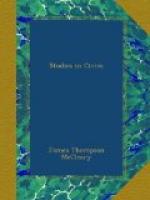A certificate of election is made out by the governor, countersigned and authenticated under seal of the state by the secretary of state, and forwarded to the president of the senate of the United States.
HOW THE ELECTORAL VOTE IS COUNTED.
“The president of the senate shall, in the presence of the senate and house of representatives, open all the certificates, and the vote shall then be counted.”—Constitution, Amendment XII.
The constitution gives no directions as to the manner of counting. No trouble was experienced, however, until the Hayes-Tilden election. The result of this election depended upon the votes of three states, each of which sent in two conflicting sets of certificates. There being no legal provision for the settlement of such disputes, the famous electoral commission was created to determine which certificates should be counted. It consisted of five senators, five representatives, and five justices of the supreme court.
The gravity of the danger thus revealed made it obviously necessary that some general plan be devised whereby such disputes might be obviated. Though consideration of the subject began at once, and various measures were from time to time proposed, no satisfactory solution was presented until February 3, 1887, when the Electoral Count Bill was passed and received the signature of the president.
An outline of the bill is here given, the principal provisions being the second and sixth as here numbered.
1. The electors shall meet and vote on the second Monday in January following their election. [Footnote: The time of meeting had been the first Wednesday in December. The change was made to give time for the settlement of any disputes, as provided in the second section.]
2. If there be any disputes as to the choice of the electors, they are to be settled in the respective states in the way that each state shall determine, provided that the laws governing the matter shall have been passed before the election, and that disputes shall have been settled at least six days before the time fixed for the meeting of the electors. A report of the contest and its mode of settlement shall be made by the governor, and forwarded under seal to the secretary of state of the United States.
3. As soon as practicable after it shall have been ascertained who have been chosen electors, the executive of the state shall transmit under the seal of the state to the secretary of state of the United States the names of the electors, with an abstract of the popular vote for each candidate for elector. The executive shall also deliver to the electors, on or before the day of meeting, three copies of said certificate, one of which the electors shall enclose with each “list of persons voted for as president and vice-president.”
4. As soon as practicable after receiving the certificates as aforesaid, the secretary of state shall publish them in full in such newspaper as he shall designate; and at the first meeting of congress thereafter he shall transmit to each house a copy in full of each certificate received.




